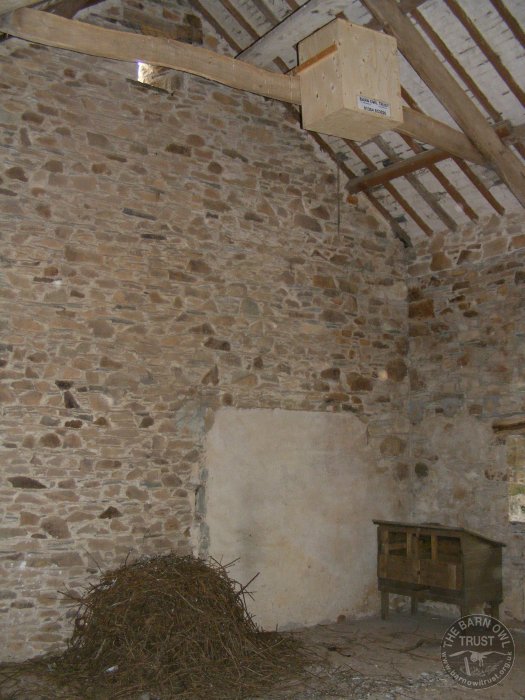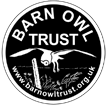Irrespective of where they are located, man-made nesting places need a certain amount of maintenance. How much will depend largely on the species of bird that has nested, the size of the nesting space provided, occupancy levels and location. What’s absolutely crucial for Barn Owls’ ‘deep’ nestboxes, is that the distance between the access hole and the floor of the nestbox is maintained to reduce the risk of young owls getting out and potentially falling prematurely.
- Clearing out
- Legality
- Timing
- Frequency
- Obstructions
- Leaks
- Security
- Health and Safety
- Record keeping
- Reporting
If you don’t know whether any wild birds are present in the nestbox, then please check the sections below on Legality and Timing. Nest cameras are helpful because you can always see what’s in there.

A nest camera can help reduce unnecessary disturbance
If you can easily access the nesting space without disturbing any birds, clear it out when the nest debris is deeper than about 50mm (2”). It doesn’t need to be spotless and there may be some advantage in leaving a very thin layer of debris. The important thing is that the drop between the bottom of the access hole and the floor of the nestbox, or nesting space, is maintained at about 460mm (18”) or more to help prevent young owls from exiting the box prematurely.
A Barn Owl nest debris is extremely compacted and can be difficult to clean out. It’s worth having something like an old screwdriver to hand and a pair of gardening gloves, with which to break up the mass before removing in chunks.
Where only Pigeons or Stock Doves have nested, little nesting material will have been introduced (usually just thin twigs or bits of straw), it won’t deter Barn Owls from moving in and can take years to reach a depth of 50mm (2”).
On the other hand, if Jackdaws have been in, then there will be a huge amount of material (sticks, wool, mud and bits of rubbish) that will need to be removed every year.
See also the section on Health and Safety issues below.
◦ Legality
The legal implications of clearing out a potential nest-place arise from the risk of disturbing nesting birds. The nests, eggs and young of almost all wild birds are protected against taking, damage or destruction under the Wildlife and Countryside Act 1981 (as amended). This affords protection from commencement of nest building until the last dependent young stops returning to the nest. For Stock Doves this makes it illegal to clear out nesting material that the birds have recently gathered with the intention of nesting. The inclusion of Jackdaw on Schedule 2 Part 2 of the Act used to allow the destruction of their nests. Now however, active nests can only be removed by an authorised person under a General Licence (GL41) if there is a demonstrable risk to human health or safety (for example if in a chimney).
A special level of protection is afforded to Barn Owls (and certain other species of bird) under Schedule 1 of the same Act. This means they are protected against intentional or reckless disturbance whilst building a nest or whilst at, on or near a nest containing eggs or dependent young. However, Barn Owls don’t build a nest as such, they generally lay eggs on the previous years’ debris but can lay on any other surface. It’s therefore extremely difficult to know what constitutes commencement of nest building for Barn Owls so it’s usually the presence of the first egg that defines the start of Schedule 1 protection. It’s worth being aware though that the period of sensitivity to disturbance usually starts more than 10 days before egg-laying.
More about the Legal protection of wild birds

Stock Doves nesting in a Barn Owl nestbox
◦ Timing
For Barn Owls, mid-winter is usually the best time for a maintenance visit, perhaps around Christmas. Choose a mild, calm, dry day and do the clear-out just before dark. That way, if a bird is inadvertently flushed from the box it won’t be forced out into inclement weather or in broad daylight, when the potential for mobbing by other species is possible.
Since Barn Owls have been recorded with eggs or dependent young in every month of the year there’s never a time to be complacent, although mid-winter is the least likely time for breeding. It’s also worth bearing in mind that the period of sensitivity to disturbance precedes egg-laying. In a mild winter it’s best to remove excess nest debris before February.
For Stock Doves, mid-winter is also a good time but bear in mind that they can and do regularly lay eggs throughout the year (see legality above). For Jackdaws the best time is in July, August, or immediately after the young have fledged and left the nest.
◦ Frequency
A typical-sized nestbox where Barn Owls produce 2 or 3 young per year, and no other birds bring anything in, will probably need to be cleared out every 2-3 years. For a built-in nesting space that is considerably larger than a typical-sized nestbox (e.g. in a roof void), checks may be conducted less frequently. This is because the nest debris is spread over a larger area.
Frequency is largely determined by activity i.e. a nest cavity that produces two broods of 3 or 4 young every year will need clearing out annually whereas a cavity that produces an average of only one young per year may not need to be cleared out for 4 years.
Since Stock Doves do not tend to introduce a lot of nesting material, checking every 2-3 years should suffice. For sites with Jackdaws, nest material should be removed annually.
◦ Obstructions
Check to see if there are any obstructions around the access hole. For external boxes that could be things like side branches or Ivy, for example. This is particularly important if visibility or accessibility of the entrance hole is compromised. Remove if necessary.
◦ Leaks
Whilst clearing out an outdoor nestbox, it’s important to check that the interior is dry. In order to fly silently Barn Owls need to keep reasonably dry and they may avoid sites that are excessively wet. Also, nest debris contain millions of small mammal hairs that are highly absorbent. This is a great advantage when the young are well-grown as the debris absorbs all their droppings and the dampness is not a problem. However earlier in the season, if the box allows rainwater in, the debris can become saturated, resulting in a clutch of eggs chilling or a recently hatched brood of young perishing. Therefore check that the box is still shedding water as it should, and that all exposed joints are still watertight. Re-seal with a weatherproof sealant if necessary.

Barn Owl nestbox emptied
◦ Security
Check that boxes are well-fixed, stable and safe. If there is any doubt that the box will still be up by the next time you check, strengthen its attachment or take it down and re-hang it. In the case of tree-mounted nestboxes, be aware that trees expand as they grow and nestboxes can literally be pushed off as the exposed parts of screws and nails gradually disappear into the tree. Similarly, anything wrapped around a trunk or branch may need to be slackened off.
◦ Health and Safety
It’s always advisable to wear gloves and face protection when clearing out nestboxes. A dust mask is essential, as is eye protection, particularly when removing Jackdaw debris. Tie your ladder off and do not over-stretch. Clearing out nestboxes at height is a difficult and often strenuous activity and it is strongly advised that you do not work alone. You are responsible for your own health and safety.
◦ Record keeping
Record the date of the check, the condition of the box and anything else that might be relevant the next time you check it. Record the evidence that you find of any species using the box.
◦ Reporting
Please report any evidence of Barn Owls roosting or nesting and sightings of Barn Owls both alive and dead at www.barnowlsurvey.org.uk
For advice on clearing out Tawny Owl nestboxes and Little Owl nestboxes please see the relevant pages.
More about Barn Owl nestboxes



